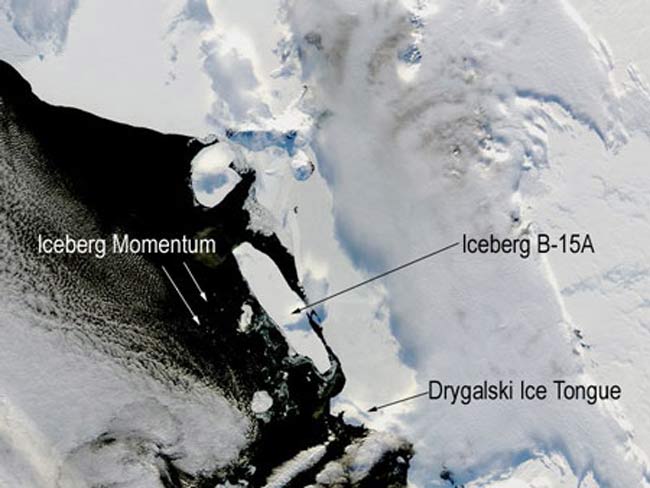Huge Iceberg to Ram Glacier

A 100-mile-long iceberg is steaming towards a floating glacier near the McMurdo Research Station in Antarctica.? NASA scientists have been following the impending smash-up in satellite images and have predicted the collision will occur no later than Jan. 15.
"It's a clash of the titans, a radical and uncommon event," said Robert Bindshadler, a researcher at NASA's Goddard Space Flight Center.
With an area of 1,200-square miles (3,000-square kilometers), the iceberg B-15A is about the size of Long Island, NY.? If it stays on its present course, it will smack bumpers with the Drygalski Ice Tongue, which is a thick frozen chunk that juts out into the Ross Sea from a land-based glacier on the western Pacific coast of Antarctica.
"Even a 'tap' from a giant can be powerful," Bindshadler said. "It will certainly be a blow far larger than anything else the ice tongue has ever experienced."
The McMurdo Research Station, located in McMurdo Sound on the Ross Sea, is the hub of U.S. scientific work on Antarctica.? In the summer months, ships unload supplies at the station for airlift to researchers at the geographic South Pole, 800 miles inland.
This summer, the humongous iceberg has trapped sea ice in McMurdo Sound, doubling the distance that icebreakers have to cut through to get to the station.? A significant "tap" might help clear some of this backlog of winter ice.
From calf to nuisance
The menacing B-15A was originally part of a larger iceberg, called B-15, which sloughed off of the Ross Ice Shelf in March 2000, in a process called calving.
Get the world’s most fascinating discoveries delivered straight to your inbox.
The shelf is a floating sheet of ice - between 600 and 3,000 feet thick and covering an area of ocean the size of Texas.? The cliffs at the water's edge are 200 feet high. Melting causes cracks to form - eventually resulting in the birth of large, flat, island-sized icebergs.
This process is slightly different in the Arctic, such that icebergs in the Northern Hemisphere tend to be much smaller and pointier.???
Many of the largest-recorded icebergs have been calved by the Ross Ice Shelf.? The iceberg B-15 - continuing with the state analogies - was as big as Connecticut.? It ran aground shortly after leaving the shelf and broke into several pieces, the largest of which is B-15A.?
This behemoth of ice recently drifted into a position that blocked McMurdo Sound - obstructing the currents that every summer sweep out the ice from the previous winter.?
Most summers, 40 miles of ice separate the McMurdo station pier and the open ocean, but now this distance is more like 80 miles.? Although there had been reports that the frozen sound might threaten supply efforts, the U.S. Coast Guard icebreaker Polar Star recently finished clearing a supply channel.
The iceberg blockade, however, may threaten the local penguin population, which must now swim farther to reach open waters where their food is.? New Zealand researchers have expressed a concern that penguin chicks may starve if their parents cannot bring back enough food.
Icy Breakout
The penguins could be helped out by the impending collision, as the Drygalski Ice Tongue might break off from the impact - allowing the escape of some of the built-up ice.
"That ice tongue has no reason for staying intact," said Waleed Abdalati, also from Goddard.
The iceberg B-15A might not be traveling fast enough to rip out the glacier's tongue, however.? The iceberg had been moving about one mile a day, but it has slowed down recently.? Still, there may be more than one ice-shattering crash.
"If B-15A bangs the ice tongue once, it could bang it again," Bindshadler said, since the tides that push on the iceberg tend to move it around in circles.



